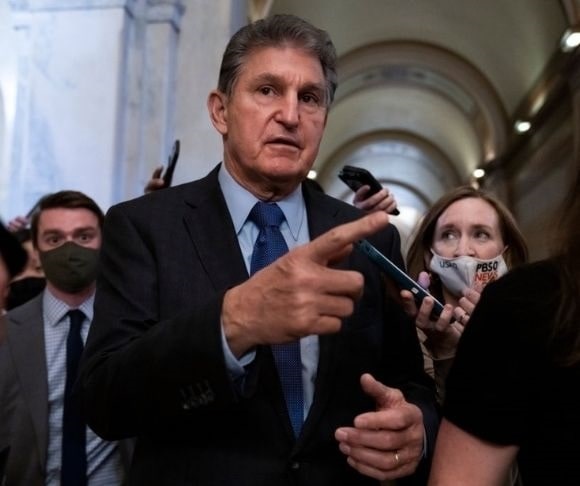The Inflation Reduction Act of 2022 has been billed as legislation to reduce the federal deficit, trim rampant inflation, and grow the economy through green energy investments. This is the marketing scheme that convinced Sen. Joe Manchin (D-WV) and Sen. Kyrsten Sinema (D-AZ), but they have been duped. Instead, the bill neither makes a dent in the massive budget shortfall nor combats inflation. Its contribution to the gross domestic product is negligible as it raises taxes on most Americans. Like the $2.1 trillion CARES Act and $1.9 trillion American Rescue Plan, this is another boondoggle in the making.
Inflation Reduction Act: Taxes
President Joe Biden, Sen. Manchin, and other Democrats keep claiming that the IRA will not raise taxes on anyone earning over $400,000. It indeed raises taxes on the wealthy, but it also confiscates income from nearly every other tax bracket. Analysis from the Joint Committee on Taxation (JCT) found that, for example, people earning less than $10,000 per year will see their average tax rate climb from 7.3% to 7.6%. The only ones who will not see their taxes rise are those earning between $10,000 and $30,000.
[substack align=”right”]The other tax proposals are ludicrous as they benefit cronies in one sector and harm innovation in another. The Inflation Reduction Act creates, extends, or revises a broad array of tax credits for green energy. It then increases the so-called Superfund tax on crude oil, slaps a 95% excise tax penalty on drug manufacturers, and institutes a 15% minimum tax on corporations with $1 billion in profits.
In addition to amplifying inflationary pressures, and extending subsidies to the rich that would reduce incentives to work, the Congressional Budget Office (CBO) warned that the corporate minimum tax rate slashes incentives for companies to invest in, such as new equipment and factories.
“In CBO’s assessment, the proposed new corporate minimum tax would reduce the incentive for those large corporations to invest, primarily by limiting the tax benefit of accelerated depreciation and by decreasing the after-tax return on their new investment,” the letter to Sen. Lindsey Graham (R-SC) said.
Inflation Reduction Act: Inflation
Today, the more than 9% consumer price index (CPI) is not because Russia invaded Ukraine or Republicans obstructed President Biden’s agenda. Instead, mounting inflation pressures commenced because Washington approved astronomical deficit-financed spending bills – monetized by the Federal Reserve – and injected trillions of dollars into a locked-down economy. Have public policymakers learned from this? No. They are emulating these measures and hoping for different results.
As Liberty Nation recently reported, analysis by the Penn Wharton Budget Model found that the bill would not do much to address inflation. In fact, researchers learned that it would add to the personal consumption expenditures index by 0.05% by 2024 and then decrease it by 0.25% later in the decade.
The administration recently touted “126 leading economists” who endorsed the landmark slimmed-down Build Back Better bill, many of whom got it wrong on multiple issues. In response, more than 230 economists penned a letter to the House and Senate leadership warning about the “inaptly named” bill that would exacerbate inflation, burden the economy, and worsen the global supply chain crisis.
Budget Deficit
Officials forecast that the legislation could slash federal deficits by nearly $300 billion over the next ten years. However, some assessments now suggest that this is unlikely. The most widely cited is the PWBM’s estimates that suggest if the Affordable Care Act (ACA) subsidies are extended to ten years, which is likely since there are no sunsets in Washington, the deficit reduction will total only $89 billion. No serious person would argue that either figure is a victory and an example of fiscal responsibility.
 Remember, the White House’s 2023 budget projects that the US government would accumulate approximately $14 trillion in deficits over the next decade. This figure will likely be higher because every administration or party spends more and adds to the shortfall. In addition, the Oval Office did not take into account higher interest rates. So, be it $300 billion or $89 billion, it is still a drop in the astronomical trough situated in the nation’s capital.
Remember, the White House’s 2023 budget projects that the US government would accumulate approximately $14 trillion in deficits over the next decade. This figure will likely be higher because every administration or party spends more and adds to the shortfall. In addition, the Oval Office did not take into account higher interest rates. So, be it $300 billion or $89 billion, it is still a drop in the astronomical trough situated in the nation’s capital.
Growth
Democrats cracked open a bottle of champagne and celebrated that the Inflation Reduction Act would contribute to the GDP by roughly 0.2% by 2032. The Tax Foundation expects the bill would trim the long-run GDP by roughly 0.1%. Even if the administration’s calculations are accurate, the government is willing to raise taxes on most Americans for a 0.2% contribution to the economy?
And then, of course, there is the issue that the tax hikes will divert resources away from the private sector to find the government waste and inefficient expenditures that will inevitably weigh on growth.
“Inflation is caused by too much money chasing too few goods. That means there are only two ways to reduce inflation: reduce the growth rate of the money supply or increase the growth rate of the economy,” wrote Institute for Policy Innovation economist David Henderson. “The act would do neither. In fact, by raising taxes and diverting resources from the productive private sector to the inefficient government sector, the act would reduce economic growth.”
Remember, economist Fredric Bastiat taught us the “That Which is Seen, and That Which is Not Seen.” In other words, the American public sees the taxpayer-funded $300 million building to support drag queen shows, but what is not seen is the $300 million that could have been used by the private sector to build plants that can hire workers and construct machinery.
A Case Study in Swamponomics
Perhaps economist Daniel J. Mitchell best summarized the Inflation Reduction Act:
“If a private company said that candy bars help you lose weight or that it is okay to stick your hand under a running lawnmower, it would be dragged into court for false and/or dangerous advertising.”
But when politicians make utterly dishonest claims about legislation, we have to grit our teeth and endure their lies.”
Overall, despite being advertised as Biden’s promise to help middle-income Americans, it is yet another bill that lends a hand to the wealthy and well-connected. The affluent will receive a $7,500 tax credit to buy electric vehicles, and multi-billion-dollar health insurance companies will receive tens of billions of dollars from the government. The left thinks it has resolved the myriad of challenges facing the economy. But, as usual, every panacea they prescribe for the nation is nothing more than a nostrum that will keep the country sick. This is Swamponomics 101.




